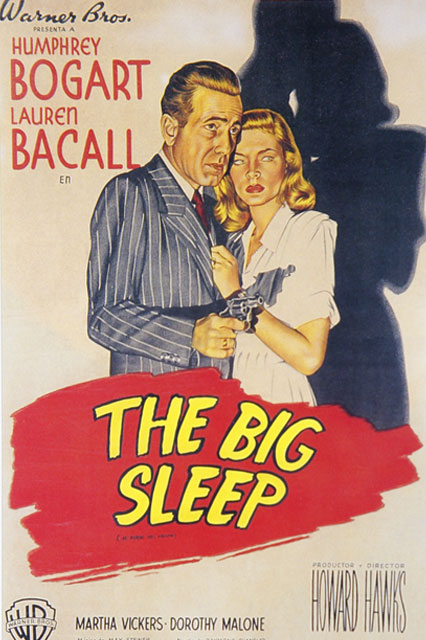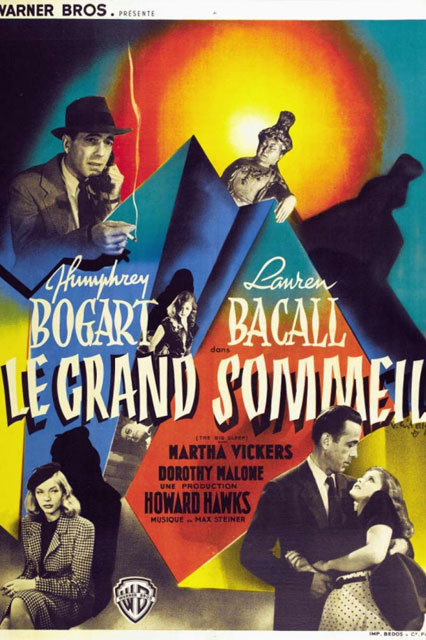The Big Sleep
1946
What Happened to The Big Sleep?
By the time The Big Sleep was released in 1946, Raymond Chandler was already an old Hollywood hand. His novel Farewell, My Lovely had already been adapted twice (first in 1942 as The Falcon Takes Over), and he’d won accolades for his screenplays for Double Indemnity and The Blue Dahlia.
But for all the Chandler films that came before and after, The Big Sleep remains king—not just of Chandler films, but of the entire genre. How could a Bogart/Bacall film based on a Chandler novel, directed by Howard Hawks, and written (in part) by William Faulkner fail?
And it didn’t. Not really. There’s no denying that The Big Sleep is a great American film, filled with great characters, snappy hardboiled dialogue, and memorable scenes. It’s beautifully shot and briskly paced. It’s become part of our collective consciousness
But there’s also no denying that it’s a bit of a train wreck. Lauren Bacall’s acting is a little wooden, there are glaring continuity issues, and most importantly, it makes no damn sense. It’s a confusing muddle of names and situations with no real conclusion. The general advice given to viewers has always been “don’t worry about the ploy, just sit back and enjoy the ride.” Still a great film of course, but a trainwreck of a great film.
As for why a film from such a powerhouse team could be so incoherent, well you could start with the famous apocryphal story. As they approached the end of the script, screenwriters Faulkner, Leigh Brackett, and Jules Furthman, together with Hawks, realized that they had no idea who their killer was. Figuring the easiest solution to this quandary was to talk to the author himself, they picked up the phone and called Chandler. Either waking him up or finding him drunk (depending on who’s telling the story), they asked the author that very simple question (“Who’s the killer in The Big Sleep?”), to which he reportedly replied, “Hell if I know.”
Even if the story itself isn’t true, there’s some truth to it. The Big Sleep, published in 1939, was Chandler’s first novel, and was essentially a patchwork of several short stories he’d written in the early ‘30s. The novel, like all those that would follow, is a serpentine affair with lots of characters and interwoven storylines. It’s a little messy, but not incoherent. It shouldn’t have been that difficult for the screenwriters to turn it into a solid mystery—and from all evidence, it wasn’t.
Until the official DVD release of the1945 edit of The Big Sleep, so far as most viewers were concerned the radically different 1946 version was the only version there was. That’s the one they saw in theaters, on television, and on home video. It was only film historians and bootleggers who knew about the original cut, and they (especially the bootleggers) tended to keep it their own little secret, passing copies from hand to hand on the sly. Only they knew that the original ’45 version made sense, while the rest of the moviegoing public scratched their heads,.
The explanation is sadly typical.
Hawks delivered the film in the spring of ’45. It was a smart, stylish, tough movie that stayed true to the spirit—and as much as possible, the letter—of the original novel. It didn’t play dumb for the audience’s sake, and those who paid attention would come away satisfied.
At the time, however, it was clear that the war was winding down so Warners wanted to rush all of their war movies into theaters while they were still viable. As a result, The Big Sleep was shelved for a year.
During that time, Lauren Bacall’s agent, Charles Feldman, was getting a little more than antsy. Critics had savaged her performance in Confidential Agent, and he had to scramble to save the young star’s career. He came up with a very simple way to do this.
Bogart and Bacall had been a huge hit in To Have and Have Not(the film that made Bacall a star). They were also a very popular celebrity couple among the proles. So why not capitalize on those two things by filming new scenes for The Big Sleep? Give her more screen time and focus on their relationship. As the film stood, she was really little more than a secondary character. If new scenes were added that were like their scenes in To Have and Have Not, well, this new picture would be a smash. Jack Warner, who had a lot of money invested in Bacall, agreed. Everyone liked the idea, so a year after wrapping the picture the new scenes were written and shot for the sole purpose of saving an investment.
Unfortunately, adding these new scenes meant cutting or reworking existing scenes. That was okay, though. Many of the scenes they chose to cut were scenes in which the plot is clarified and explained, but that dinner scene between Bogart and Bacall was just too important. (A detailed look at all the scenes cut and changed is available on recent commercial editions of the DVD).
So plot be damned, continuity and coherence be damned, Philip Marlowe’s fundamental character be damned, the studio ran with the new edit. Well, the film came out in ’46, and it was a big hit. Better still, according to plan it salvaged Bacall’s career. All of which goes to prove something, though I’m not sure what. To be honest, I’m not sure I want to know, either.
-Jim Knipfel
Copyright 2015

